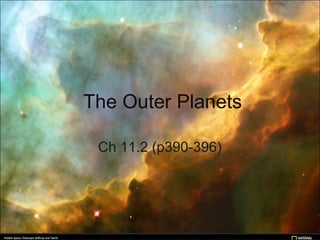Chapter 11.3: The Outer Planets
•Als PPT, PDF herunterladen•
1 gefällt mir•853 views
Grade 8 Integrated Science Chapter 11 Lesson 3 on the outer planets. This lesson discusses the four outer planets. It gives details on their composition, atmosphere, rings, moons, and other identifying details.
Melden
Teilen
Melden
Teilen

Empfohlen
Weitere ähnliche Inhalte
Was ist angesagt?
Was ist angesagt? (20)
Dwarf Planets and Pluto / Kuiper Belt and Oort Cloud

Dwarf Planets and Pluto / Kuiper Belt and Oort Cloud
Ähnlich wie Chapter 11.3: The Outer Planets
Ähnlich wie Chapter 11.3: The Outer Planets (20)
Mehr von Korrnell Academy: L Class Grade 8 Science
Mehr von Korrnell Academy: L Class Grade 8 Science (20)
Kürzlich hochgeladen
God is a creative God Gen 1:1. All that He created was “good”, could also be translated “beautiful”. God created man in His own image Gen 1:27. Maths helps us discover the beauty that God has created in His world and, in turn, create beautiful designs to serve and enrich the lives of others.
Explore beautiful and ugly buildings. Mathematics helps us create beautiful d...

Explore beautiful and ugly buildings. Mathematics helps us create beautiful d...christianmathematics
Kürzlich hochgeladen (20)
Web & Social Media Analytics Previous Year Question Paper.pdf

Web & Social Media Analytics Previous Year Question Paper.pdf
Explore beautiful and ugly buildings. Mathematics helps us create beautiful d...

Explore beautiful and ugly buildings. Mathematics helps us create beautiful d...
Basic Civil Engineering first year Notes- Chapter 4 Building.pptx

Basic Civil Engineering first year Notes- Chapter 4 Building.pptx
Energy Resources. ( B. Pharmacy, 1st Year, Sem-II) Natural Resources

Energy Resources. ( B. Pharmacy, 1st Year, Sem-II) Natural Resources
Food Chain and Food Web (Ecosystem) EVS, B. Pharmacy 1st Year, Sem-II

Food Chain and Food Web (Ecosystem) EVS, B. Pharmacy 1st Year, Sem-II
Presentation by Andreas Schleicher Tackling the School Absenteeism Crisis 30 ...

Presentation by Andreas Schleicher Tackling the School Absenteeism Crisis 30 ...
Ecological Succession. ( ECOSYSTEM, B. Pharmacy, 1st Year, Sem-II, Environmen...

Ecological Succession. ( ECOSYSTEM, B. Pharmacy, 1st Year, Sem-II, Environmen...
Z Score,T Score, Percential Rank and Box Plot Graph

Z Score,T Score, Percential Rank and Box Plot Graph
Chapter 11.3: The Outer Planets
- 1. The Outer Planets Ch 11.2 (p390-396)
- 2. Vocabulary • Galilean moons (393) – The four largest moons of Jupiter – Io, Europa, Ganymede, and Callisto – which were first discovered by Galileo Galilei in 1610
- 3. The Gas Giants • The outer planets are called the gas giants because they are primarily made of hydrogen and helium. • They have strong gravitational forces due to their large masses. – The strong gravity creates tremendous atmospheric pressure that changes gases to liquids. – Most these planets have thick gas and liquid interiors covering a small, solid core
- 5. Jupiter • Largest planet – – – – 11 times the diameter of Earth Twice the mass of all the other planets combined Rotates faster than any other planet Like all outer planets, it has a ring system
- 6. Jupiter’s Atmosphere • • • • 90% hydrogen, 10% helium 1000km deep Dense, colorful clouds Because Jupiter rotates so quickly, the clouds stretch into bands • The Great Red Spot is a storm of swirling gases
- 7. Jupiter’s Structure • 80% hydrogen, 20% helium • Thick solid core • 1000km past the outer edge of the cloud layer, the pressure is so great hydrogen gas changes to liquid • Scientists do not know what the core is made of – They suspect it is rock and iron
- 8. The Moons of Jupiter • Jupiter has at least 63 moons • The 4 largest were discovered by Galileo in 1610 – We call these Galilean Moons • Io, Europa, Ganymede, and Callisto • All made of rock and ice • Collisions between Jupiter’s moons and meteorites likely resulted in Jupiter’s rings
- 10. Saturn • 6th planet • Has horizontal bands of clouds • 90% hydrogen, 10% helium • Least dense planet – Its density is less than that of water
- 11. Saturn’s Structure • Similar to Jupiter – An outer gas layer, a thick layer of liquid hydrogen, and a solid core • Ring system is the largest and most complex – 7 bands of rings, each containing thousands of narrower ringlets – Main ring system is over 70,000km wide and less than 30m thick
- 12. Saturn’s Moons • At least 60 moons • 5 largest – Titan, Rhea, Bdione, Iapetus, and Tethys • Most of Saturn’s moons are chucks of ice less than 10km in diameter • Titan is larger than Mercury – It is the only moon in the solar system with a dense atmosphere – In 2005 the Huygen probe landed on Titan
- 13. Uranus • 7th planet • Narrow, dark rings • Deep atmosphere composed mostly of hydrogen and helium and some methane – The methane gas gives it a bluish color • Beneath the atmosphere is a thick, slushy layer of water ammonia, and other materials • Below that is a solid, rocky core
- 14. Uranus’s Axis and Moons • Uranus has a tilted axis of rotation – Maybe caused by a collision with an Earth-sized object • At least 27 moons – Largest are Titania and Oberon (smaller than our moon) • Titania has an icy cracked surface that might once have been covered by an ocean
- 15. Neptune • Discovered in 1846 • Atmosphere is like Uranus – Hydrogen, helium, and some methane • Interior is also like Uranus – Partially frozen water and ammonia with a rock and iron core • 13 moons and a faint ring system – Triton is the largest. It has a surface of frozen nitrogen and geysers that erupt nitrogen gas • Swirling storm s and high winds sometimes exceeding 1000km/h
